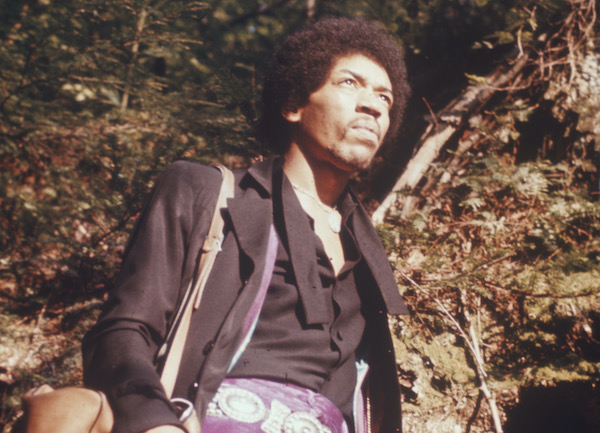Oct 28, 2025 10:47 AM
In Memoriam: Jack DeJohnette, 1942–2025
Jack DeJohnette, a bold and resourceful drummer and NEA Jazz Master who forged a unique vocabulary on the kit over his…

There’s something admirable about the Jimi Hendrix estate’s willingness to put their name on Live In Maui, a warts-and-all document.
(Photo: Courtesy Experience Hendrix)As fascinating as it is to hear Live In Maui (Experience Hendrix/Legacy Recordings/Sony Music Entertainment 19439799042; 51:34/48:45 ****), a thrilling document of a July 1970 Jimi Hendrix Experience performance for a few dozen fans in a pasture situated near the Haleakala Crater, the story of how this show came to pass is perhaps even more captivating.
Hendrix, drummer Mitch Mitchell and bassist Billy Cox had a Honolulu stadium gig and some much-needed downtime in Hawaii on their schedule. But instead of relaxing, the trio were coaxed by manager Michael Jeffrey into taking part in Rainbow Bridge—a cockamamie, independent art film—and playing a hastily assembled gig as part of what was dubbed a “vibratory color/sound experiment.”
What maybe helped convince the band to brave 30 m.p.h. winds and a gaggle of people grouped together by their astrological signs was that Jeffrey got Reprise Records to fund the construction of Hendrix’s Electric Lady Studios. Or maybe—according to interviews with Chuck Wein, the film’s director, on the DVD accompanying this multidisc set—the guitarist was on board with connecting the “enlightened and unenlightened” via that “rainbow bridge.”
Whatever the case, Hendrix and the Experience gave their all at this unusual gig, which stretched over two sets—one that stuck to familiar tunes like “Foxey Lady” and “Purple Haze,” and another that highlighted material the group recorded for what would have been its fourth studio album. Footage from the performance wound up in the finished film—which also featured a wonderfully grouchy cameo from Hendrix—but, strangely, the 1971 soundtrack was made up entirely of unused studio material.
There’s a notable looseness to the first set that only becomes more pronounced as it moves through its 10 tracks. Mitchell’s playing gets especially ragged, with awkward fills and his struggling to find the downbeat on “Lover Man.” The drummer’s work wasn’t helped by technical issues with the original multitrack recordings and the raging winds that affected several songs. (Mitchell later would rerecord the drum parts for several songs that feature in the performances here.)
By the second set, a measure of stiffness creeps into the group’s playing, underlining how new some of these songs were to the trio. The Experience is still comfortable enough turning “Hey Baby (New Rising Sun)” and “Midnight Lightning” into a medley on the fly, but the punch and swing of funk-infused rockers like “Dolly Dagger” is tempered. The trio also occasionally loses sight of the finish line, as an otherwise wonderful take of “Straight Ahead” seems to crumble toward the end.
There’s definitely something admirable about the Hendrix estate’s willingness to put their name on this warts-and-all document. That decision was made a lot easier thanks to Hendrix’s stellar work here. Even at its shaggiest, his playing is never anything less than electrifying. He especially excels on the slow blues numbers: His solo on “Hear My Train A-Comin’” starts off humbly before he unfurls a furious squall of notes and fuzzed-out chords; and the band’s churning version of “Red House” is filled with the guitarist’s quick melodic curlicues and playful energy.
Whether Hendrix was onstage that afternoon as a favor to his manager or to be part of this proto-New Age experiment can’t ever be made clear—even with the filmed concert footage. What does come across as loudly as the music is just how much he loved playing with Mitchell and Cox, and how much Hendrix enjoyed performing for an audience. When he’s not completely lost in the music or plucking out a solo using his teeth, he looks entirely joyful.
Hendrix’s death less than three months later might cast some small shadow on the ebullience displayed here, but don’t let it linger. Put these discs on repeat and soak in every moment like an afternoon in the Hawaiian sun. DB
This story originally was published in the February 2021 issue of DownBeat. Subscribe here.

Jack DeJohnette boasted a musical resume that was as long as it was fearsome.
Oct 28, 2025 10:47 AM
Jack DeJohnette, a bold and resourceful drummer and NEA Jazz Master who forged a unique vocabulary on the kit over his…

Goodwin was one of the most acclaimed, successful and influential jazz musicians of his generation.
Dec 9, 2025 12:28 PM
Gordon Goodwin, an award-winning saxophonist, pianist, bandleader, composer and arranger, died Dec. 8 in Los Angeles.…

Flea has returned to his first instrument — the trumpet — and assembled a dream band of jazz musicians to record a new album.
Dec 2, 2025 2:01 AM
After a nearly five-decade career as one of his generation’s defining rock bassists, Flea has returned to his first…

Nov 13, 2025 10:00 AM
For results of DownBeat’s 90th Annual Readers Poll, complete with feature articles from our December 2025 issue,…

To see the complete list of nominations for the 2026 Grammy Awards, go to grammy.com.
Nov 11, 2025 12:35 PM
The nominations for the 2026 Grammy Awards are in, with plenty to smile about for the worlds of jazz, blues and beyond.…








